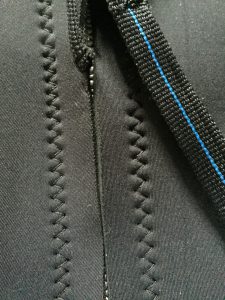Yea! You’re finally done with renting wetsuits!
You know what some people do in those wetsuits… oops a bladder leak!
There are a couple of ways you can purchase your wetsuit. The first is to go to your local supplier and talk face to face with a qualified sales rep. This is much easier but you may not always find what you’re looking for especially if you have done some wetsuit researches online and find there’s a greater variety of wetsuits to choose from.
The other is to make your purchase online after doing some researches.
Before you jump into buying a wetsuit, there are some things I want you to think about when looking for your right wetsuit.
First, why do you want to buy a wetsuit?
Purchasing your very own wetsuit is a great investment for several reasons:
1) It’s yours
2) It fits right
3) It feels comfortable
4) It will last you a long time
What’s the purpose of a wetsuit?
You’re looking around for a wetsuit because those rented ones didn’t seem to fit you properly. Do you remember feeling cold during your dives? You shouldn’t have to have experiences like these.
A good wetsuit will give you the following:
1) Warmth! Its main purpose is to keep you warm.
2) Protection from scrapes from coral and jellyfish stings.
3) Provide buoyancy
What type of diving do you want to do?
 Decide on what type of diving really fancies you. Do you want to do more cave diving, cold water diving… perhaps you just want to dive someplace warm?
Decide on what type of diving really fancies you. Do you want to do more cave diving, cold water diving… perhaps you just want to dive someplace warm?
Many divers have more than 1 wetsuit to suit their dive locations. I have 2 wetsuits… one for warm water diving and the other for diving in the Pacific Ocean… cooler water.
Think about the following questions here and jot your answers down on a piece of paper…
1) What are you interested in? – deep diving, night diving, cold water diving, cave exploring, wreck diving…
2) How deep will you be diving?
3) Where do you want to go diving? Geographic locations – mountain lakes, Caribbean…
4) When do you want to go diving? Consider the seasons – spring, summer, fall, winter.
5) What are the water conditions likes? Cold, warm, reefs…
6) What is the likely weather condition? Rainy, cold, very hot…
What are the types of wetsuits (styles)?
Choosing the type of wetsuit depends on the type of diving you do. If you like cold water diving then you should look at drysuits.
4 types of wetsuits:
1) Shortie
- Wonderful to wear in warm water (temperature 22 C / 72 F)
- Fits just above the knees.
- Usually short-sleeved.
- Gives you lots of flexibility.
- Gives you no protection against jellyfish stings and scrapes from coral.
 2) Full Length
2) Full Length
- You get better thermal insulation and will keep you much warmer.
- Gives you protection from jellyfish stings and scrapes from coral.
- Most wetsuits come with zippers at the ankle making it easier to get your feet into and out of the wetsuit.
3) Dive Skin
- Water temperature 25 C / 77 F or warmer.
- Although not considered a wetsuit, some divers will wear this as their protection to coral.
- Material is spandex or lycra and provides you no real warmth.
- Give you lots of flexibility when worn by itself.
- Some will wear their full length wetsuit or shortie over the dive skin making the wetsuit much easier to slip on and off.
4) Drysuits
The idea behind drysuits is your body doesn’t get wet underwater!
- Great for cold water diving. Lakes.. Ice diving.
- The air in your suit is your insulator.
IMPORTANT:
If you’re interested in buying a drysuit and have never used a drysuit, I highly recommend you take a speciality certification course on drysuit diving which you can take at any dive shops or resorts who offer cold water diving.
You can also go on the internet and check out dive training agencies like PADI, NAUI and SSI for more information. The course teaches you how to wear the drysuit, the functionality, buoyancy, hazards, experience in open water… everything you need to know to be a safe diver wearing the drysuit.
How do you want your wetsuit to fit? Getting the right fit!
It’s really important your wetsuit fits you properly!
If your wetsuit is too big, you risk too much water seeping into your wetsuit. This defeats the purpose of keeping you warm.
If your wetsuit is too tight it will also mean it’s tight around your neck. This can prevent circulation at your neck which can cause you to blackout during your dive.
Here’s what you want for your perfect fit…
1) Your wetsuit should fit you snug, as in tight to your body.
2) You must still be able to maintain your natural body flexibility.
3) When I buy brand new shoes I usually find I have to wear them at home for a few days just to get them to stretch. The same applies with your wetsuit.
After a few dives in your new wetsuit it should stretch enough in all the right places to give you your ‘perfect’ fit.
4) Getting the Right Thickness! This is important because your body needs to keep warm. The easiest way to determine this is your environment, type of water and type of diving.
Remember:
a) The deeper you go, the more compression in your wetsuit which means you will feel colder!
b) The thicker your wetsuit, the more buoyancy you will get and have less natural flexibility.
Wetsuit thickness is measured in millimetres.
1mm:
- This is not really referred to as a wetsuit but as a dive skin.
- Wear in very warm water and hot outside temperature 85 F. Example – Caribbean summer.
2mm:
- Water temperature 29 C + / 85 F
- Wear in warm water with hot outside temperature – Caribbean summer.
3mm:
- Water temperature 21 – 28 C / 70 – 85 F
- Perfect for diving in the Caribbean
5mm:
- Water temperature 16 – 20 C / 60 – 70 F
- Example – Pacific Ocean in the summer
7mm:
- Water temperature 10 – 20 C / 50 – 70F
- Around the 50 F, you might want to start thinking about a drysuit.
5) There are different manufacturers with different makes and styles. You will need to check with the supplier’s sizing chart because they go by their standard stock. If you fall in between the sizes.. Don’t worry!! All you need to do is look at the next size up as long as it’s not a noticeable variance. If it is look at a different supplier.
6) Now a days, you can go on the Supplier’s Chat online and give them your basic measurements like your height, weight and chest size or be more specific and give them your detailed measurements:
– around your head
– around your neck
– mid-neck to wrist bone
– neck-base to crotch
– bust
– waist
– hips
– crotch to ankle bone
7) Wetsuit Fabrication (Material)
Wetsuits are made out of foamed neoprene. This foamed neoprene has gas bubbles so when you dive deeper, your wetsuit will start to compress even more because of the water pressure. When you’re diving, some water will seep into your wetsuit. That water when warmed up by your body becomes your insulation. Wetsuits create buoyancy and so weights are required.
8) Wetsuit Stitching
If you’re looking for quality in a wetsuit, then knowing how the wetsuit is stitched is equally important to get your comfort and watertightness.
2 Stitches to look for:
 Flat Lock Stitch (Flat Seam)
Flat Lock Stitch (Flat Seam)
- Used on wetsuits that are 3mm thick or less
- Less expensive than blind stitch so the wetsuit costs less
- Look like smooth train tracks and makes the wetsuit feel more comfortable
- This stitch is better for warm water because some water will still seep into the wetsuit
Glued Blind Stitched Seams
It’s called the Blind Stitch because you can only see the stitching on the one side. The needle only goes thru half the material.
Sometimes, you may see stitching on both sides and the needle still doesn’t go all the way thru.
- Used more on drysuits for cold water diving. (50 F or less).
- Prevents water from entering the suit.
- Narrower than the Flat Stitch.
- Process involves gluing, pressing seams together and then stitching.
- The seams can stretch to help you get flexibility.
Cost of a wetsuit
Purchasing your right wetsuit depends on the thickness and the type of wetsuit. It can range anywhere from $150.00 to $800.00. The most popular wetsuit thickness is 3mm to 5mm and price is relatively inexpensive.
Any Questions?
Well… that’s it folks! Thanks for reading and I hope this all helps you make your right decision in purchasing your wetsuit. Getting your ‘perfect’ wetsuit is like a dream come true!
I really would like to hear from you.. any questions and comments are welcomed below in my comment box below. Please let me know what wetsuit you purchased and how it felt during your dives.
Hey, are you interested in my review on a great wetsuit? Come check this out!

Hi Monica. Very informative article here. I’m sure you’ve had your fair share of wetsuits and diving =)
I’m interested in the dry suit as I’m not really that good with cold water. Does dry suit really stop all water touching our body? And when you mention that we need a special training to use dry sis, does it means it’s harder to use than normal wetsuits?
Hi Isaac,
Thank you for your comment!
Properly fitted dry suit will keep water from coming into your suit. You wear booties and gloves for your feet and hands.
Most of us divers learn to dive in a wetsuit and become skilled on using our BCD (Buoyancy Control Device) to control our buoyancy along with our breathing. You learned how to put air into your BCD on descent and release air on ascent.
I don’t think dry suits are harder to use.
With the drysuit, you need to re-learn these skills. This means learning how to put air and release air into your drysuit. Learning to control your buoyancy is always important.
Certification card is not required but it’s a good idea to get some kind of training on dry suit operation for safety and care. You can practice the skills in confined water with someone you know that is knowledgeable with drysuit diving before venturing into open water.
Thanks Isaac, I hope this helps!
Monica
What a nice website 🙂
I have been thinking about buying a wetsuit/drysuit for the last few years but it has always seemed a bit of an extravagance considering the amount of times I actually manage to go diving! However, I think if I invested in one it would encourage me to go more!
Obviously I would not want to carry one with me abroad but I am thinking of buying one to use at home (I live in the UK). Obviously the waters are cold here – would you recommend a dry suit or could I get away with a full-length (perhaps 5-7mm) one? I’d only be diving in the warmer months.
Thanks!
Hi Louise!
Thank you!
Great question! If you’re going to be diving in the summer in the UK, you can go with either a 5mm or 7mm (thickness) full length wetsuit. I would probably wear my 7mm full length wetsuit…It gives me less natural flexibility but at least I will be warm enough to enjoy my dives. Some divers feel cold half way through their dives.
You won’t need a dry suit unless the weather in the summer turns out rainy and cold… cools the ocean too… if you go diving in mountainous areas (lakes) you would probably want a dry suit.
5mm:
Water temperature 16 – 20 C / 60 – 70 FExample – Pacific Ocean in the summer
7mm:
Water temperature 10 – 20 C / 50 – 70FAround the 50 F, you might want to start thinking about a drysuit.
I hope this helps you Louise! Enjoy your dives and let me know what suit you decide on!
Regards,
Monica
Thanks Monica, that’s great advice! 🙂
Hi Louise,
You’re welcome! Let me know which one you choose…
I have only been scuba diving once and it was exactly how you described, cold and smelling of pee…..th at might have been me though.lol
I have always wondered if people actually have their own wetsuits that they use just for themselves or if they rent every time. Do you have to change them after so long or do they last quite well?
Hey Matthew, thank you for your comment and question.
I’m certainly guilty of that as well. It’s the water temperature and the pressure on your body that makes you want to pee… Peeing is a common occurrence among divers and there are certainly ways to try to avoid as much as possible like… no caffeine, and staying warm.
Most divers after they decide they want diving as their passion, will purchase their own wetsuit.
Renting a wetsuit is always convenient because you have more room in your suitcase to pack other things but that’s a lot of pee filtering thru those wetsuits over the years.
Your wetsuit is an investment and should last you for years as long as it’s looked after properly, even after peeing in it. I had a wetsuit for 6 years and that was doing around 550 dives with a 5 ml thickness, now mind you it did get thinner and was just right for Caribbean diving. The Sink the Stink works!!
Regards,
Monica